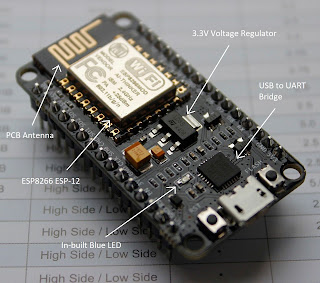Getting Started with NodeMCU ( ESP8266 )
Till now we have been talking about Arduino and stuff related to it. In this post we will be talking about another type of micro-controller i.e. NodeMCU. It is a wifi module chip which can be connected to internet for IoT ( internet of things ) projects.
Introduction
NodeMCU is a open-source IoT platform. It has the firmware which works on ESP8266 WiFi Soc and hardware which is based on Esp-12 module. Soc ( System of chip ) is an integrated circuit which integrates all the components of a computer. It uses the LUA scripting language.
There are two ways to program it. One is with ESPlorer IDE using the Lua scripts. Another is using the Arduino IDE. All you need to do in the IDE is :
File -> Preferences -> Enter
http://arduino.esp8266.com/versions/2.4.1/package_esp8266com_index.json -> OK
Tools -> Boards -> Board manager -> Install ESP8266 boards
ESP8266
The ESP8266 is a 32-bit low-cost Wi-fi microcontroller produced by Chinese manufacturer, Espressif Systems. It is the CPU of NodeMCU with XTOS operating system. It has and 10 GPIO pins all of which are PWM. It supports SPI, I2C and UART.
Apart form ESP8266, NodeMCU contains the voltage regulator and the In-circuit Serial Programmer which makes it easy to power the module via USB and program it. Just like the Arduino, it also has the in-built LED on the pin GPIO16. There is also another LED of ESP-12 connected at GPIO2 which blinks when the code is being uploaded. Both the LEDs are blue in color.
Pin Configurations have to be kept in mind when using NodeMCU.
Introduction
NodeMCU is a open-source IoT platform. It has the firmware which works on ESP8266 WiFi Soc and hardware which is based on Esp-12 module. Soc ( System of chip ) is an integrated circuit which integrates all the components of a computer. It uses the LUA scripting language.
There are two ways to program it. One is with ESPlorer IDE using the Lua scripts. Another is using the Arduino IDE. All you need to do in the IDE is :
File -> Preferences -> Enter
http://arduino.esp8266.com/versions/2.4.1/package_esp8266com_index.json -> OK
Tools -> Boards -> Board manager -> Install ESP8266 boards
ESP8266
The ESP8266 is a 32-bit low-cost Wi-fi microcontroller produced by Chinese manufacturer, Espressif Systems. It is the CPU of NodeMCU with XTOS operating system. It has and 10 GPIO pins all of which are PWM. It supports SPI, I2C and UART.
- Processor : L106 32-bit RISC microcontroller
- Operating Voltage : 3-3.6V
- Frequency : 80 MHz
- Operating Frequency range : 2.4-2.6 GHz
- 10-bit Analog to digital converter
- Memory : 128 KB
- On-board 2.4 GHz PCB Antenna
Apart form ESP8266, NodeMCU contains the voltage regulator and the In-circuit Serial Programmer which makes it easy to power the module via USB and program it. Just like the Arduino, it also has the in-built LED on the pin GPIO16. There is also another LED of ESP-12 connected at GPIO2 which blinks when the code is being uploaded. Both the LEDs are blue in color.
Pin Configurations have to be kept in mind when using NodeMCU.





Gerçekten faydalı bilgiler içeriyor, teşekkürler.
ReplyDelete